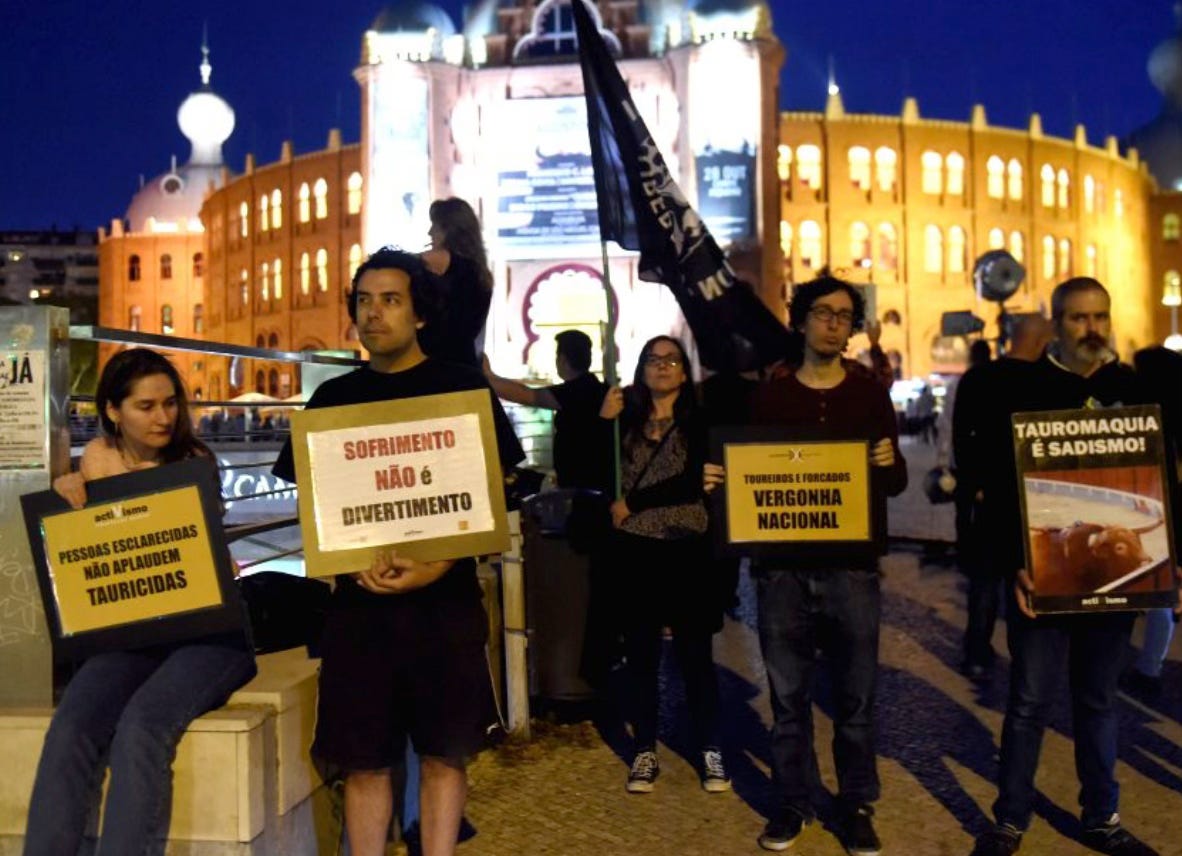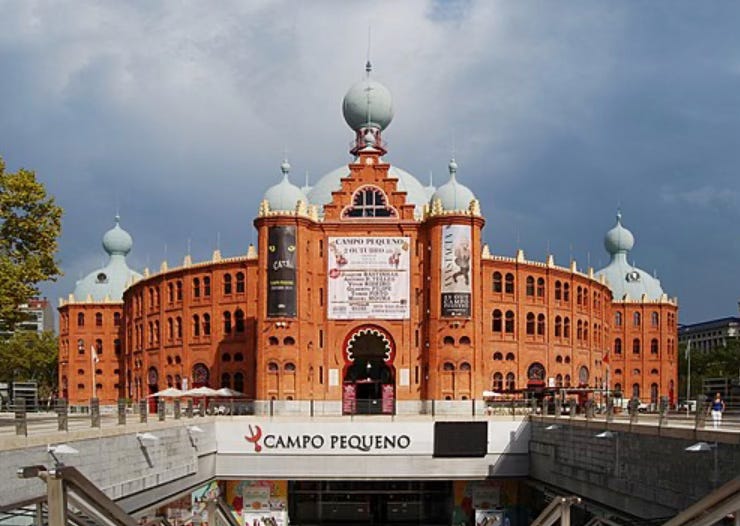At first, there were only three TV channels (in Philadelphia 3, 6 and 10). But in the late 60’s, UHF channels 17, 29, and 48 came online. I needed to rearrange the rabbit-ear antenna on my small black-and-white TV set…but I could watch Mexican bullfights on Friday nights. I was a child, oblivious to the cruelty.
What are they Protesting?
On Thursday, 4 July, I was in Lisbon for the evening. I had made reservations at my “go-to” hotel, Luzeiros Suites.1It was 21:00 and I was having a falafel sandwich and beer at a cafe nearby. Across the street, I noticed a large gathering of people with flags, banners, and signs. They didn’t seem very happy. I asked the waiter, “What are they protesting?” When he told me “bullfighting”, I nearly fell off my chair.
I mean this is a country where it is illegal to euthanize a healthy dog.
In Portugal, therefore, it is illegal to kill an animal for the sake of population control — e.g. a perfectly healthy stray dog, caught and taken to a kennel or shelter, can never be put down, irrespectively of how long it will stay there; If healthy, the dog can only die of old-age, for anything else will be illegal. 2— Medium
I never expected bullfighting to be legal in Portugal. But it is…
I also never imagined the ornate, orange-brick, circular building across the street from my hotel was a bullring. We had visited the building before and accessed it as a seedy, failing mall.3
Portuguese Bullfighting
If my memory is correct, I recall three stages of the bullfights I watched as a child on TV. There were guys with pointed sticks, men on horseback, and finally the matador with a red cape and sword. The bull was killed. Portuguese bullfighting differs somewhat. I would never go to watch a bullfight so I did some online research for this post.
The bullfighter, or "cavaleiro," rides a well-trained horse and showcases the horse's agility and skill. In addition to the cavaleiro, there are also two other participants in a Portuguese bullfight: the "forcados" and the "quadrilha." The forcados are a group of eight men who stand in a line and try to grab the bull by its horns, wrestling it to a standstill without harming it or themselves….The objective of the cavaleiros is to place a series of spears, called "ferros", on the bull's back muscle….After the cavaleiros have finished, a group of bullfighters on foot, known as "forcados", enter the arena. Their job is to call the bull and get it to charge them, while avoiding its attacks. Then, in line, they wrestle it to a standstill. The bull is then led out of the arena and returned to the fields. — Azores Adventures
Those who view bullfighting as a cultural event, say that the “sport” exemplifies the training and skill of the horses and riders. However, one reviewer on TripAdvisor offered a different view:
But first, this is a bullfight, people. If you're an animal lover, hate the sight of blood, or don't want to see what is unquestionably a cruel art, don't go! The bulls may not be slaughtered as in the more famous Spanish version, but the goal still remains to stick spears into the back of an enraged bull until he is bloody and weak. - TripAdvisor
It should also be noted that severely injured bulls are not returned to the fields, but rather are sent to the butcher.4
Decreasing Popularity
The popularity of bullfighting in Portugal is on the decline. Over the past 10 years, there has been a 30% decline in the number of bullfights and many rings have closed. Yet on a Thursday night in the summer of 2024, the cruel practice (and protests) continue.
“A bullfight is not culture, it is torture. Sooner or later it will have to stop – and we have come out here to show that”. -- Protester at a rally in 2021
“It is incomprehensible that in the 21st-century animals are still being tortured in an arena in the public space” — Inês Sousa Real, spokesperson for the PAN party
Até à próxima semana, tchau
Nanc
More Survey Results: As is my custom. I continue to share the reader survey results. The most popular topics are: (1) Observations of an American on Portuguese culture, etc., (2) Immigrating and Figuring out how to live in Portugal, (3) Travel and Places to Visit, (4) Financial Matters (cost of living, banking, taxes, etc.) and All of the Above are all of those tiny slices.
Always immaculately clean, with attentive staff, the hotel is adjacent to the Campo Pequeno metro stop on Avenida da Republica. They offer modern hotel rooms and huge, traditionally furnished suites. Depending on the season rooms range from 80-140€/night…which is quite reasonable for a hotel in the capital city.
Just so you know, there are still many concerns related to animal control and treatment in Portugal. The article referenced above speaks to some of them.
Built-in 1892, Portuguese architect António José Dias da Silva’s design was inspired by a famous bullring in Madrid. Restored in 2006, around and below the bullring one finds, a shopping area, restaurants, a cinema, and underground parking. As the bullfighting season is relatively short (Easter - August) the 8000-seat arena also hosts concerts, trade shows, and exhibitions.
In Portugal, more than 4,000 bulls a year are killed for bullfighting and other cruel events.








Bull fighting is tragic ... regardless of the extent to which they torture the animal – we lived in Costa Rica where they don't kill it – and based on that, we attended one and it was basically a drunken orgy of young men teasing and cajoling the animal to fight back – and always an audience thrill when one of the teasers was chased by the bull. It's certainly a lingering remnant of patriarchy where men have dominion over, well, everything. Of course, while we're pointing a sharp finger at Portugal, a country we live in at their pleasure, it's a good reminder that the U.S. government was putting migrant children in cages under Trump, a prime example of entrenched patriarchal values. Just sayin'
We live very near campo pequeno and find the mall to be a convenient place to pick up groceries and sometimes by KFC! When the bullfight date is close, a car drives through the neighborhood announcing it with an excited and loud voice. That always gives me hope they are not getting very many customers and maybe it’s dying.
I came from a state that has an annual rodeo in every major city. I found those too to be so cruel to animals basically either terrifying them and/or torturing them. But every year it was a huge event. I think sometimes people just want to not think of how cruel
the acts are for the selfish act of “entertainment.” I would lay odds that bullfighting will stop long before rodeos in the US.